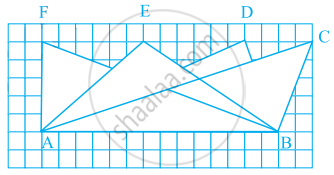Advertisements
Advertisements
प्रश्न
Prove that (2, -2) (-2, 1) and (5, 2) are the vertices of a right-angled triangle. Find the area of the triangle and the length of the hypotenuse.
उत्तर
The distance d between two points `(x_1, y_1)` and `(x_2, y_2)` is given by the formula
`d = sqrt((x_1 - x_2)^2 + (y_1- y_2)^2)`
In a right-angled triangle, by Pythagoras theorem, the square of the longest side is equal to the sum of squares of the other two sides in the triangle.
Here the three points are A(2,−2), B(−2,1) and C(5,2).
Let us find out the lengths of all the sides of the triangle.
`AB = sqrt((2 + 2)^2 + (-2-1)^2)`
`= sqrt((4)^2 + (-3)^2)`
`= sqrt(16 + 9)`
`AB = sqrt25`
`BC = sqrt((-2-5)^2 + (1 - 2)^2)`
`= sqrt((-3)^2 + (-4)^2)`
`= sqrt(9 + 6)`
`AC = sqt(25)`
Here we have
`BC^2 = AB^2 + AC^2`
50 = 25 + 25
Since the square of the longest side is equal to the sum of squares of the other two sides the given triangle is a right-angled triangle.
In a right-angled triangle, the area of the triangle ‘A’ is given by,
A = 1/2 (Product of both the sides containing the right angle)
In a right-angled triangle, the sides containing the right angle will not be the longest side.
Hence the area of the given right-angled triangle is,
`A = ((sqrt(25))(sqrt(25)))/2`
= 25/5
A = 12.5
Hence the area of the given right-angled triangle is 12.5 square units
In a right-angled triangle, the hypotenuse will be the longest side. Here the longest side is 'BC'.
Hence the hypotenuse of the given right-angled triangle is `5sqrt2` units
APPEARS IN
संबंधित प्रश्न
If A(4, –6), B(3, –2) and C(5, 2) are the vertices of ∆ABC, then verify the fact that a median of a triangle ABC divides it into two triangle of equal areas.
In each of the following find the value of 'k', for which the points are collinear.
(7, -2), (5, 1), (3, -k)
Determine the ratio in which the line 2x + y – 4 = 0 divides the line segment joining the points A(2, – 2) and B(3, 7).
If A, B, C are the angles of a triangle, then ∆ = `|(sin^2"A", cot"A", 1),(sin^2"B", cot"B", 1),(sin^2"C", cot"C", 1)|` = ______.
Points A(–6, 10), B(–4, 6) and C(3, –8) are collinear such that AB = `2/9` AC.
If the points A(1, 2), O(0, 0) and C(a, b) are collinear, then ______.
Area of a triangle = `1/2` base × ______.
Observe all the four triangles FAB, EAB, DAB and CAB as shown in the given figure.

- All triangles have the same base and the same altitude.
- All triangles are congruent.
- All triangles are equal in area.
- All triangles may not have the same perimeter.
In the given figure, area of ΔPQR is 20 cm2 and area of ΔPQS is 44 cm2. Find the length RS, if PQ is perpendicular to QS and QR is 5 cm.

Using determinants, find the area of ΔPQR with vertices P(3, 1), Q(9, 3) and R(5, 7). Also, find the equation of line PQ using determinants.
